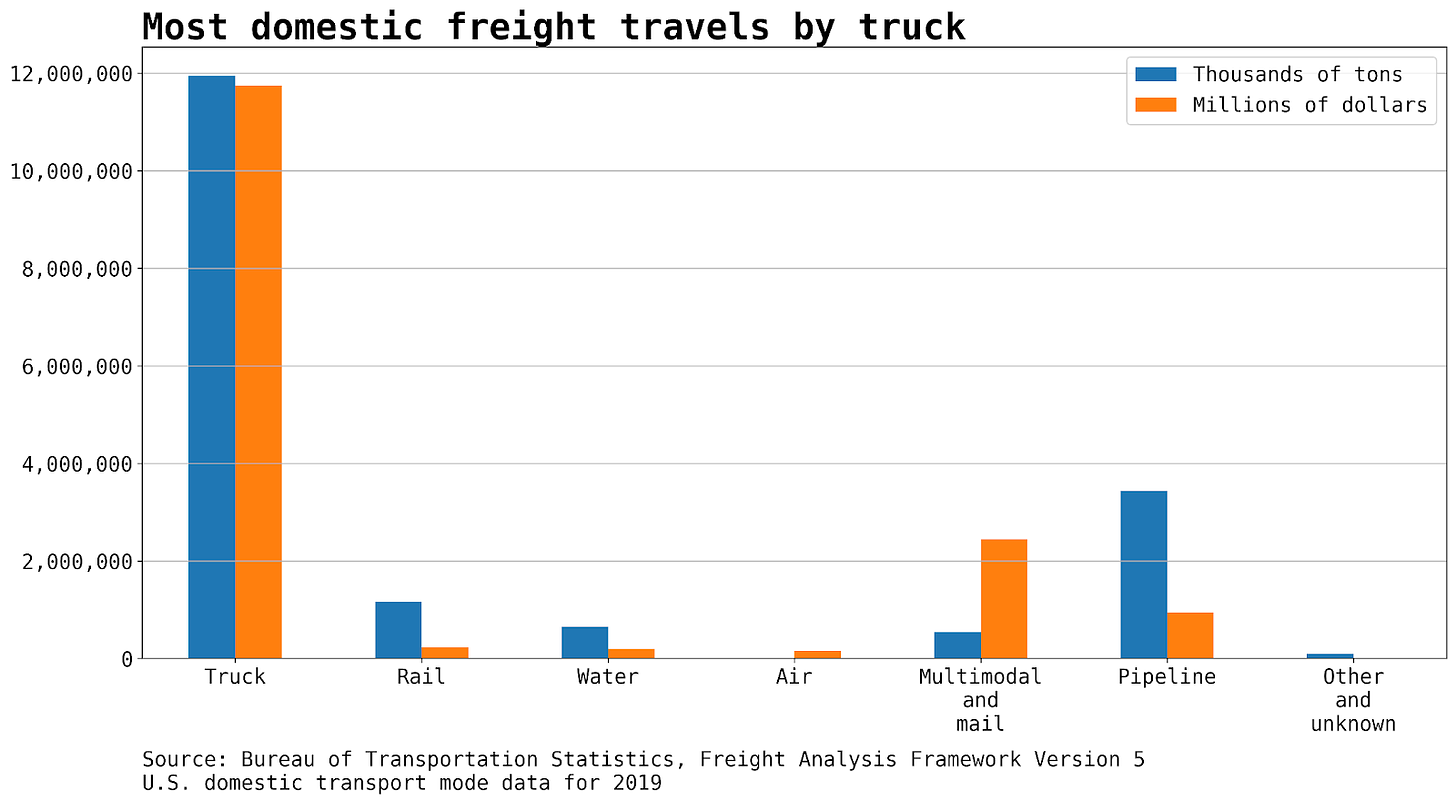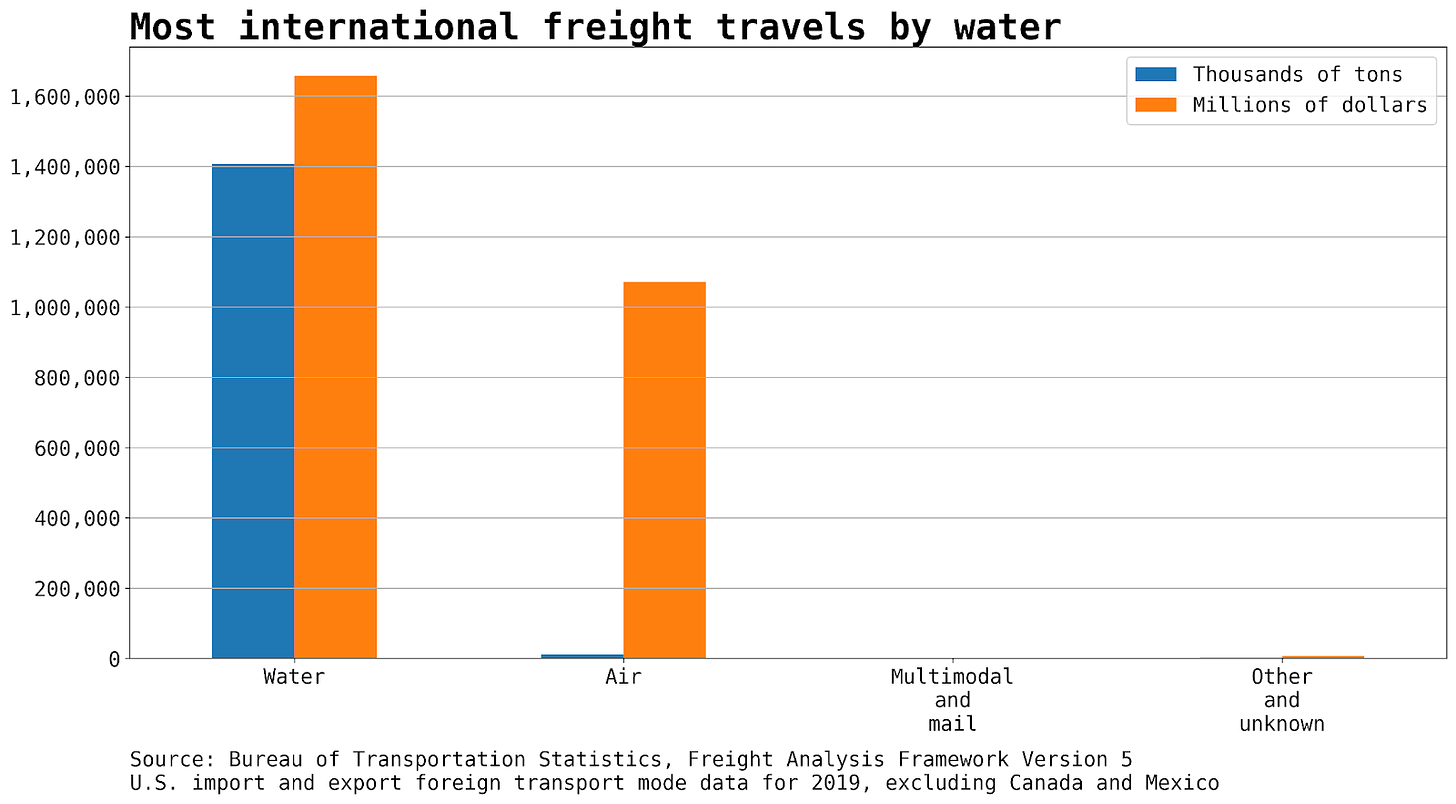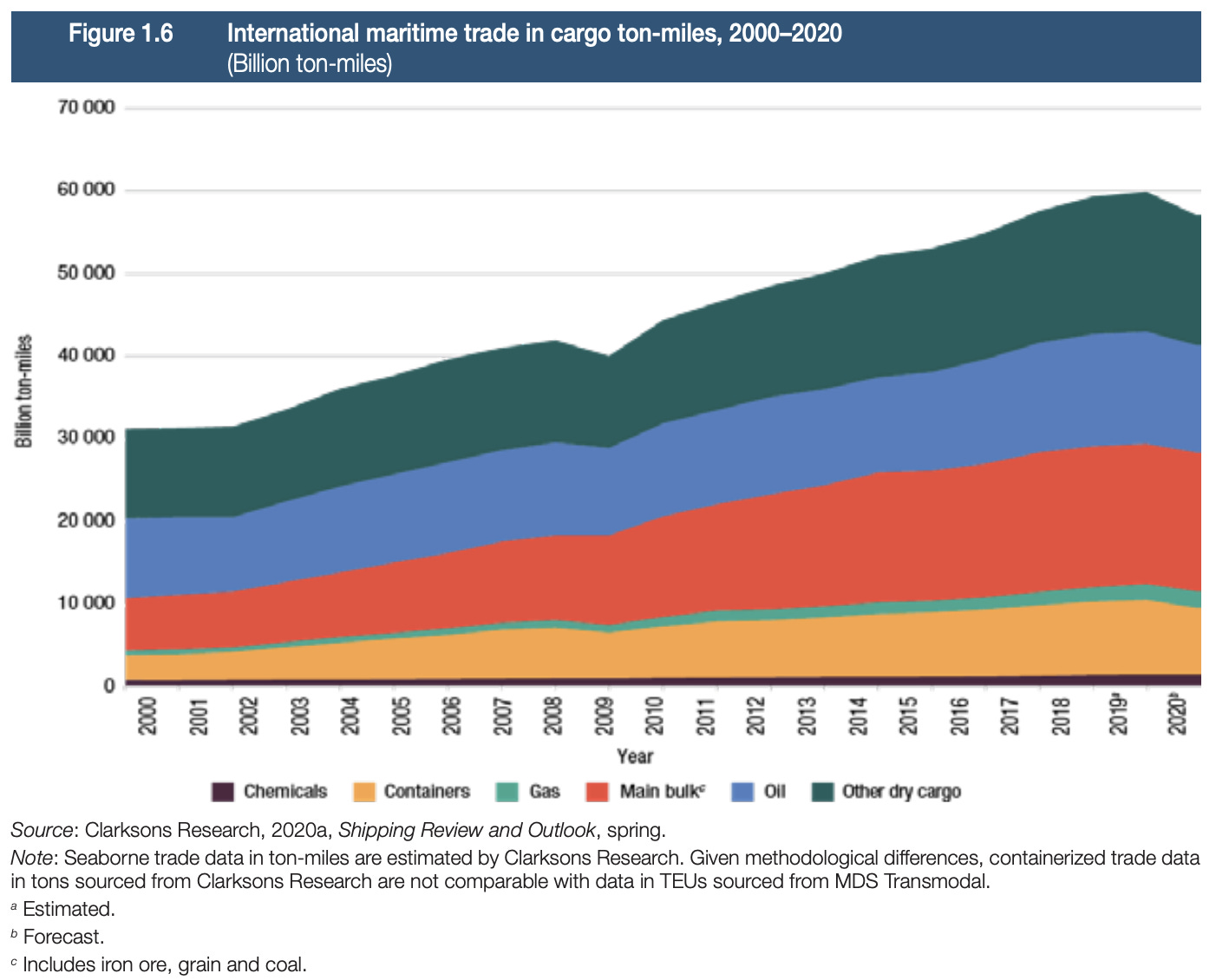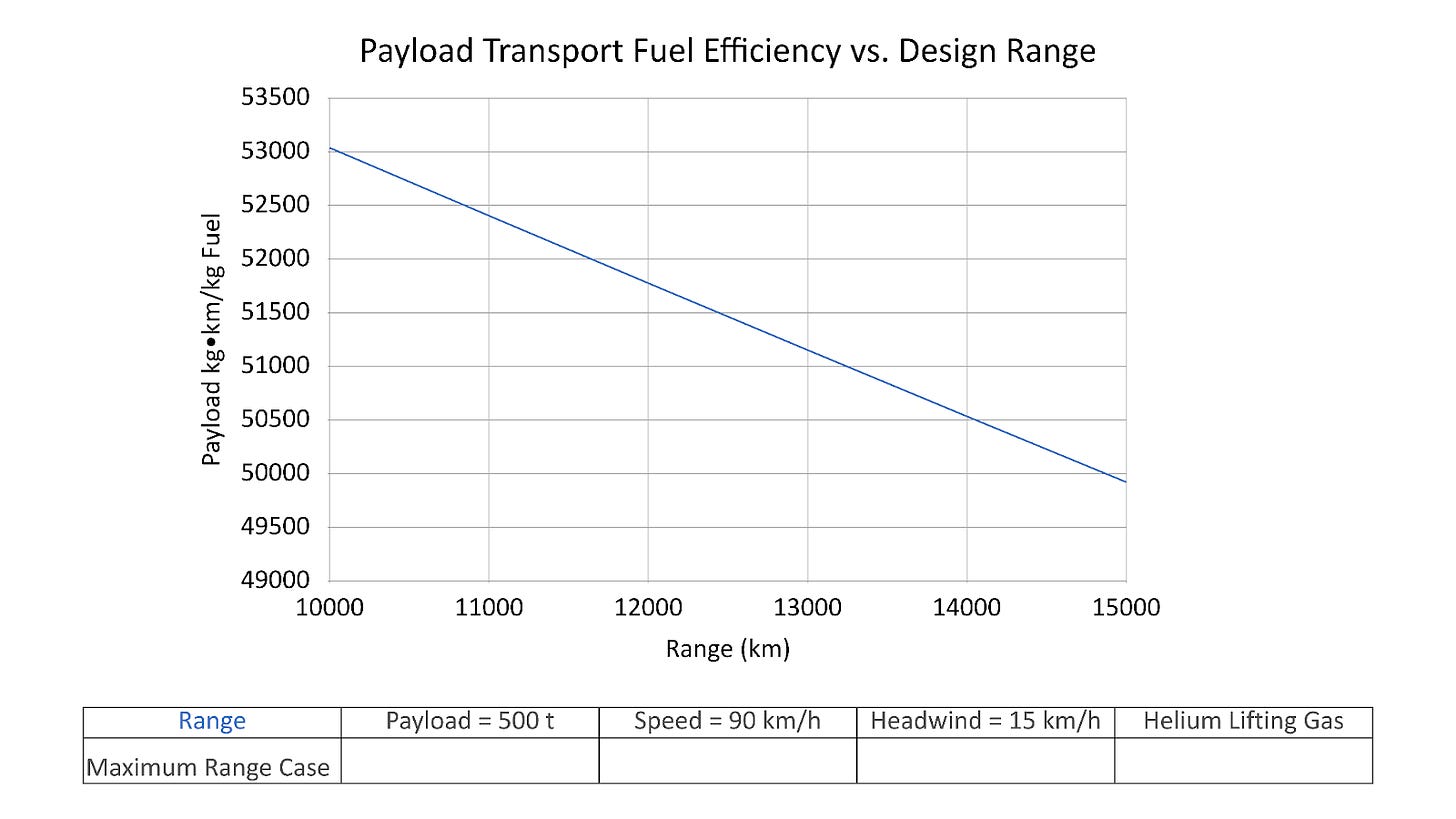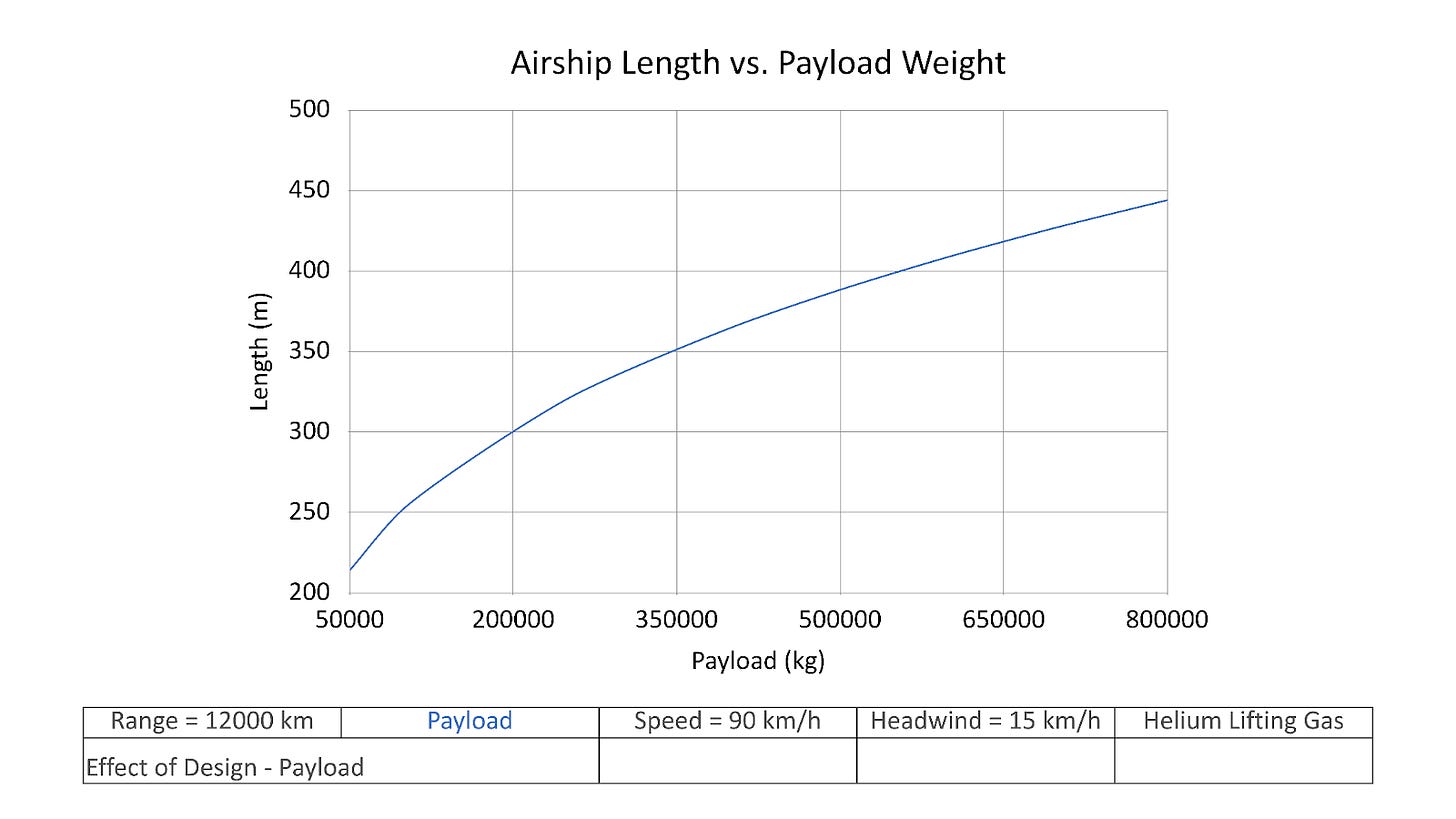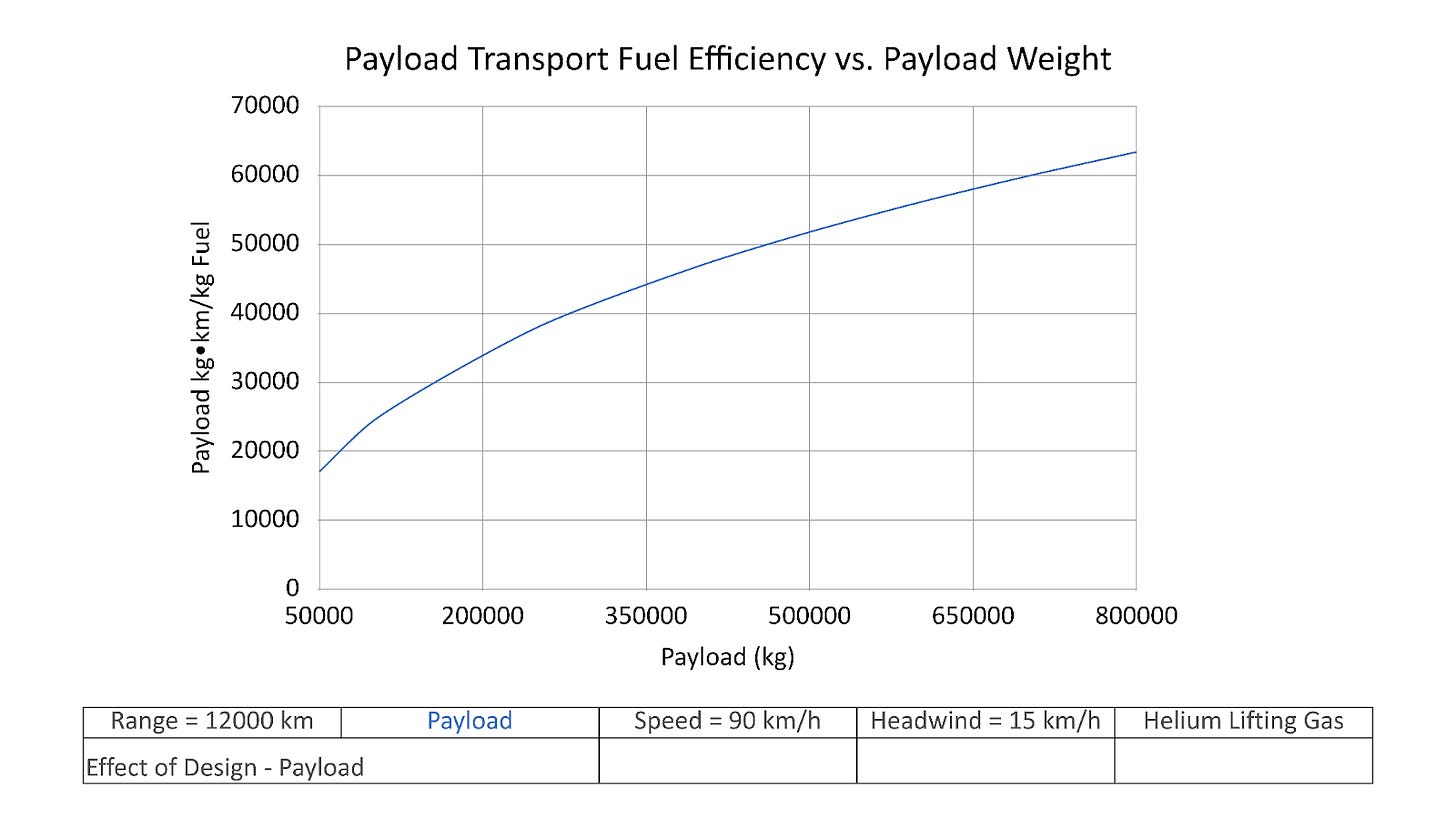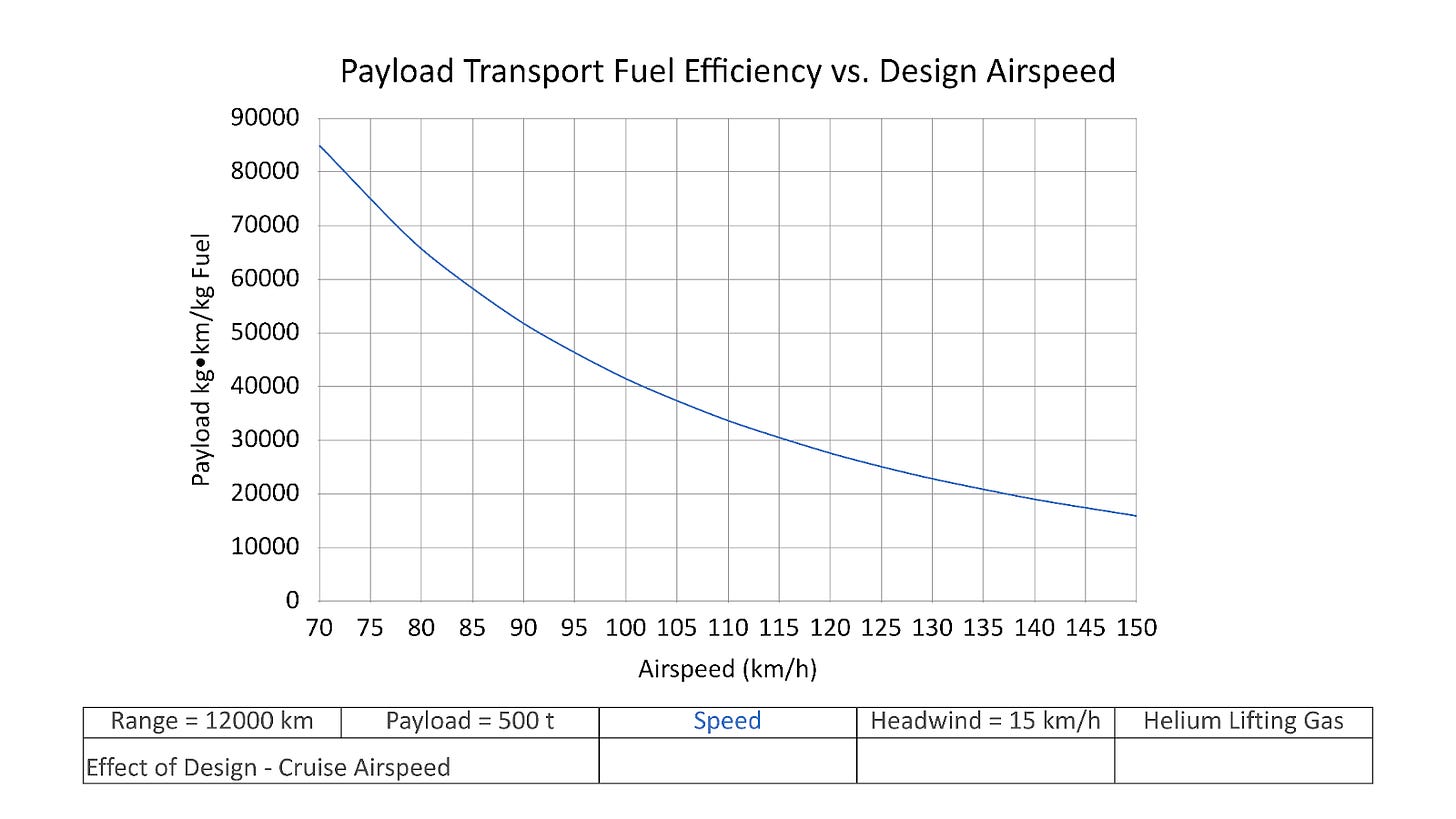

Cargo airships could be big
source link: https://www.elidourado.com/p/cargo-airships
Go to the source link to view the article. You can view the picture content, updated content and better typesetting reading experience. If the link is broken, please click the button below to view the snapshot at that time.
Cargo airships could be big
A capital-intensive, high-risk way to revolutionize global commerce
A lot of people think that the Zeppelin era ended merely because the Hindenburg erupted into flames in front of newsreel cameras, killing 35 of the 97 people on board in the inferno.
While the 1937 accident certainly didn’t help, the writing was already on the wall for passenger airship service. In the late 1930s, airplanes were finally getting good. The DC-3, which is still technically in service today, was introduced in 1936. By 1939, you could cross the Atlantic in less than a day on Pan Am’s Boeing 314 Clipper. And after World War II, the Lockheed Constellation, with its pressurized cabin, 5,400-mile range, and 340-mph cruise speed took over the transatlantic market.
Passenger airship demand was headed to zero no matter what. Airplanes won because they were faster.
But there is another market that is not as sensitive to speed: freight. A shipping container doesn’t suffer detrimental health effects from sitting for hours on end. It doesn’t complain about yet another airplane meal. It doesn’t feel gross if it doesn’t get a shower. It doesn’t get bored on a long flight.
Could airships make a comeback serving the freight market? The idea is compelling, but it faces serious obstacles. Along with my friends Ian McKay and Matt Sattler, I have spent a lot of time thinking about how to make cargo airships work. Here’s what we think.
Airship scaling laws
The physics of airships are unbelievably seductive.
All aircraft are subject to four forces: thrust and drag in the direction of travel, and lift and gravity in the vertical direction. For an aircraft in steady flight, the vertical and horizontal forces are in balance.
A useful way to summarize the performance of an aircraft is via the lift-to-drag ratio.
If an aircraft can generate more lift and/or produce less drag, the performance of the aircraft is higher.
For an airship, which gets lift from lifting gas (aerostatic lift) instead of from wings (aerodynamic lift), the amount of lift is proportional to the volume of lifting gas. The drag is proportional to some combination of cross-sectional area and wetted area—in any case, it increases with area.
The performance of an airship, therefore, is proportional to volume divided by area. As an airship increases in size, both the volume and the area of the airship increase, but the volume always increases faster than the area. The volume is a function of length cubed, while the area is a function of length squared.
This simple square-cube law means that, in principle, the performance of an airship gets better as it gets bigger. Forever.
If your airship performance isn’t good enough, just double it in size. The lift will increase by a factor of 8, the drag will increase by a factor of 4, and the lift-to-drag ratio will therefore double. Still not good enough? Do it again. 🤯
To do cargo airships right, we need to make the biggest flying objects over created. A modern cargo airship would make the Hindenburg puny by comparison.
How big is the market for cargo airships?
The market for cargo airships is massive if they can match the economic performance of trucks. To show this, let’s first look at the domestic freight market. I’ll use 2019 data so that the analysis isn’t skewed by Covid.
According to the Bureau of Transportation Statistics, average revenue per domestic ton-km is about 83¢ for air freight, 11¢ for trucks, and 2¢ for water transportation (in spite of the Jones Act). These modes are not equivalent in terms of the time it takes to get your goods—if they were, we would expect water transportation, which is cheapest, to take the whole market. Air freight will get cargo to your destination the same day, trucks will take a few days, and ships will take longer.
What we observe under these conditions is that, domestically, most of both the tonnage and value of cargo is transported via truck. Trucks are neither the fastest nor the cheapest mode of transport, but they provide a great value proposition—you get your stuff in a few days for much cheaper than air freight.
In the international market, the situation is different.
First, the costs are different. Both air and water freight are cheaper internationally than they are domestically. According to Boeing, in 2019 the global air cargo industry carried about 264 billion revenue-ton-kms and earned about $106 billion in revenue. This works out to about 40¢ per ton-km, less than half the cost of US domestic air freight. International water transportation is also cheaper than domestic, perhaps around 1¢ per ton-km.
Second, some modes are missing because a lot of countries are not connected by land. Looking at US import and export data, and excluding Canada and Mexico where US roads, rail, and pipelines connect, water transportation has claimed the majority of both the tonnage and the value. Airplanes carry less than 1 percent of the tonnage but about 39 percent of the value.
What if we introduced a new international freight mode? Suppose that, like trucks, it could get you your stuff in a few days instead of in a month or more via container ship. Suppose also that, like trucks, it was several times cheaper than today’s air freight.
By analogizing the international market with the domestic market, it seems possible that many customers, perhaps the majority by both tonnage and value, would choose the new truck-like mode.
How big would the global market be? Eyeballing a chart from UNCTAD’s annual Review of Maritime Transport 2020, containerized international maritime trade is around 8 trillion ton-miles, or about 13 trillion ton-km (out of a total of about 96 trillion ton-km of total international maritime trade).
Let’s say airships captured half of the 13 trillion ton-km currently served by container ships at a price of 10¢ per ton-km. That would equal $650 billion in annual revenue for cargo airships, notably much bigger than the $106 billion Boeing reports for the entire global air freight market. If one company owned the cargo airship market, taking only half of only the container market, it would be the biggest company in the world by revenue.
How many airships would we need to fill that demand? A lot. If each airship can carry 500 tons, cruises at 90 km/h, and is utilized two-thirds of the time, that adds up to around 260 million ton-km per year per airship. To produce 6.5 trillion ton-km per year would require 25,000 such airships. This is about the number of airliners in the world today.
None of this analysis yet assumes any expansion of the market from normal growth, from the availability of a new service class, or from the ability to go point-to-point rather than shipping between existing ports. But it’s easy to imagine new trading patterns and even new companies forming because cargo airships exist. Just as Uber and Lyft massively expanded the vehicle-for-hire market, the added supply chain flexibility afforded by airships would stimulate new demand.
Airship engineering basics
Airships come in three flavors: blimps, rigid-body, and semi-rigid.
Blimps are basically balloons with gondolas and motors attached. Like a balloon, they are overpressurized relative to the ambient air in order for them to hold their shape. This means that the hull skin of a blimp is constantly in tension. The amount of tension increases with the size of the blimp, which means that blimps can’t scale in size forever. At some point the stress on the hull fabric is too great for the material. Alternatively, the hull fabric has to become so thick that the weight becomes a problem.
You can push this limit to some extent with exotic materials. For example, Lockheed Martin has a design for a blimp with a 21-ton payload that uses a kevlar-based material for the hull. This airship, called the LMH-1, is notionally only the first in a line of airships. Lockheed says they could go up to 500 tons with this design, due to the strength of their special fabric.
However, if you might want to go bigger than 500 tons, or if you don’t want to use exotic materials in your high-volume production line, you probably want a rigid-body airship. A rigid-body airship, like the Zeppelins of yore, uses a system of internal trusses to keep its shape. Inside the hull, there are a series of gas cells, basically big bags of a lifting gas like hydrogen or helium. Unlike a balloon, these gas cells are not overpressurized relative to the ambient atmosphere. If they were to spring a leak, they would not rapidly deflate like a balloon—they would instead slowly mix lifting gas with air at the point of the leak.
Nothing regarding the truss system or the gas cells suffers from scaling limits. If you want a bigger airship, you can just scale up the design, adding trusses where necessary. In fact, the weight of the structure decreases as a fraction of lift as you get bigger. This means that the performance of rigid-body airships scales better than square-cube. Gas cells also can scale, either because you can have bigger gas cells or because you can have more of them as the hull increases in size.
The downside of a rigid-body airship is that the minimum viable airship size is much bigger than for a blimp. The structure of the hull adds weight, so you need enough lifting gas to overcome that weight, which you don’t get until the airship is a decent size.
In between a blimp and a rigid-body airship is a semi-rigid airship. A semi-rigid airship is like a blimp in that there are no gas cells and the hull is overpressurized relative to the ambient atmosphere, but it does have some internal structure to provide support. The amount of structure is not as much as in a fully rigid airship, and therefore the weight penalty is not quite as high.
These days, the Goodyear “Blimp” is no longer a blimp at all, but rather a semi-rigid airship made by Zeppelin Luftschifftechnik GmbH, the company founded by Ferdinand von Zeppelin to make rigid-body airships. Is that clear?
Another airship design strategy that is trendy these days is to make the airship “hybrid,” meaning that it requires a combination of aerostatic and aerodynamic lift to fly, at least when it is fully laden. The hull itself is an airfoil that generates lift with forward motion. This allows the airship to lift more than it could with a given quantity of lifting gas, but it also means that the airship loses the ability to hover and station-keep. Like an airplane, it has to keep moving forward not to crash into the ground.
In this post, I am considering only rigid-body non-hybrid airships as a possible solution for the intercontinental cargo market. We want massive scale and we don’t want to lose the option to come to a stop and float.
Trade study for a 500-ton airship
To get a flavor for the performance of a cargo airship, we asked an extremely experienced aeronautical engineer to parametrically size an airship based on historical airship size and performance data. Our base requirements were as follows:
Range: 12,000 km
Payload: 500 metric tons
Cruise speed: 90 km/h
Assumed headwind: 15 km/h
Lifting gas: helium, for conservatism
Our engineer came back to us with the following design outputs:
Fineness ratio: 5
Length: 388 m
Diameter: 78 m
Gas volume: 1,129,380 m³
Gross weight: 1,051,362 kg
Empty weight: 422,601 kg
Fuel: 128,761 kg
Cruise shaft power: 3,435 kW
This would be by far the biggest aircraft ever built.
A gross weight of 1,051 tons is 64% bigger than the 640-ton maximum takeoff weight of the late Antonov An-225. A length of 388 meters is 58% bigger than the Hindenburg’s 245 meters. Lifting gas volume of 1,129,380 m³ is more than 5.6 times the Hindenburg’s measly 200,000 m³.
As our engineer cheerfully noted, the fuselage of the Airbus A380, the world’s largest passenger aircraft, would not be out of place on our airship as a gondola. It is only 73 meters long.
After sizing the vehicle, our engineer performed some trades, varying one free parameter at a time to see how it affects the other aircraft characteristics. Varying range scales the vehicle roughly linearly—if you want to increase the range to 15,000 km, you obviously need to carry more fuel, so the vehicle gets a little bigger and more powerful. For this 25% increase in range, you add about 2% in length, 5% in gas volume, and 4% in cruise shaft power. You also have to increase fuel by about 30%. All told, the 25% increase in design range reduces payload transport efficiency by about 3.5%.
The story is different when we vary payload instead of range. As I noted above, airships benefit from a square-cube law as they increase in size. Lift scales with volume and drag scales with area. This means that bigger airships are better, and smaller airships are much, much worse.
Let’s look first at how the length of the airship varies with payload. As you can see below, there is a steep penalty for reducing airship size. To carry a payload that is only 40% as large as our 500 tons, you still have to make the airship 77.5% as long. To carry a payload that is only 10% as large as ours, you still have to make one about 56% as long! Meanwhile, to add 60% additional payload capacity, you only have to increase the length by 15%.
How does this affect transport efficiency? It’s a massive effect. You reduce transport efficiency by 36% if you reduce payload by 60%, and you reduce efficiency by 65% if you reduce payload by 90%. On the other hand, if you increase payload by 60%, you get a 21% improvement in transport efficiency.
For airships, bigger is clearly better.
Another important parameter to look at is design cruise speed. When I initially started thinking about cargo airships, I thought it would make sense to take a cue from Hindenburg, which cruised at 125 km/h. As I will discuss below, maybe that is still the right choice, but even at that speed, you are on the wrong side of some unpleasant math.
The power needed to drive an airship is proportional to velocity cubed. Because the mission takes less time when the ship is moving faster, the total mission fuel required is proportional only to velocity squared. The net effect is that transport efficiency decreases quadratically with cruise speed.
Nevertheless, there are a couple of factors that still militate for a faster design cruise speed. I’ll discuss them in the next section.
Other cargo airship design considerations
Autonomy. If you’re taking a load of cargo across the Pacific Ocean on a multi-day journey, you can’t expect a single crew to be awake and on duty the entire time. Making the airship unmanned not only saves you crew salaries, it lets you delete a lot of crew support infrastructure on the airship—the bunks and galleys and heads. This saves weight, money, and complexity.
Cargo airships would probably be among the easiest vehicles to make unmanned. The sky is big and empty, but it’s especially empty over the ocean at the lowish altitudes, below airliners’ Class A airspace, where airships would fly. Even when you get over land and near landing facilities, airships are slow moving relative to other aircraft, so there is time for a remote pilot to take over if any off-nominal condition occurs.
Lifting gas. In our study, we assumed helium as the lifting gas in order to be conservative. As I’ve noted in a blog post for the CGO, current FAA guidance disallows the use of hydrogen as a lifting gas.
Yes, hydrogen burns, and that can be hazardous, as the Hindenburg showed. But there were many, many horrible accidents in the early days of aviation, and we have dealt with the risks they uncovered through better engineering. In the last year or so, I have heard rumors of some European companies that want to use hydrogen lifting gas, so it’s possible that EASA could lead the way and FAA would eventually follow.
Hydrogen has some significant benefits over helium as a lifting gas. First, it is lighter and supplies about 8% more gross lift. One thing that should be obvious from our trade study is that an improvement in gross lift would carry through the rest of the design. For given performance requirements, it would decrease the required volume of lifting gas, reduce the length and diameter of the structure, reduce total drag, reduce required shaft power, reduce empty weight, reduce fuel requirements, and increase transport efficiency.
The other major benefit to hydrogen is that it is much cheaper than helium. The USGS estimates the private sector price of helium to be $7.57/m³, while hydrogen is sometimes available for $0.11/m³. It would cost almost $8 million to fill our 500-ton airship with helium, and just over $100k to fill it with hydrogen. Lifting gas doesn’t get used up the same way as fuel does, but through leaks and venting, it wouldn’t be just a one-time charge. Hydrogen is cheap enough that you can design to vent it to help keep the ship trim.
Finally, there is a genuine question of whether the world has enough helium for a cargo airship fleet. As we noted above, if half the ocean container market gets upsold to airship service, that is demand for around 25,000 airships. That works out to about 26 billion m³ of lifting gas. The USGS estimates that the entire planet has helium reserves of around 40 billion m³. Global helium production is only around 160 million m³ per year, enough for about 141 airships.
There is a lot that is unrealistic here. If we tried to run a global airship fleet on helium lifting gas, the price of helium would skyrocket, making the economics worse. Other industries that use helium would complain. Helium production could perhaps increase a bit, but it would still take many decades or even a century to saturate the airship market.
In short, for this industry to reach scale, hydrogen lifting gas is a must. Whether you could start with helium for the first few airships and transition to hydrogen later is an open strategy question.
Both hydrogen and helium gas would leak out of the gas cells over time. They are very small molecules and and it’s hard to make light, truly impermeable membranes. To prevent hydrogen from accumulating outside the gas cells and posing a fire risk, it would be important to design adequate ventilation systems inside the hull.
Materials. By extrapolating from the rigid-body airships of the past, our study implicitly assumed aluminum as the material for the airship’s truss structure. Most companies working on airships today have chosen to use carbon fiber instead. Carbon fiber has a much better tensile-strength-to-weight ratio than aluminum does, but it isn’t nearly as good as aluminum at handling buckling loads. Accordingly, the only way to use carbon fiber safely is to do a ton of finite element analysis to determine the particular locations on the structure where you need extra support.
Another consideration is simplicity in manufacturing. If you’re assuming a production line that is going to turn out 25,000 airships, welding metal is much simpler than setting carbon fiber. There are super cool thermoplastic carbon fiber composites that can be kinda-sorta welded, but there’s still a remaining question as to how strong the joints would be against buckling loads.
Another possibility would be to use magnesium metal instead of aluminum. Magrathea Metals is an early-stage startup producing magnesium metal from brines. If they can get the cost of magnesium metal down lower than aluminum, it’s possible magnesium would be a good option for airships. Magnesium is lighter than aluminum, both castable and weldable, and stronger than carbon fiber (and aluminum!) against buckling loads.
Fuel. Ideally, airship fuel would be neutrally buoyant, the same density as the surrounding air. This would ensure that as the fuel burned off throughout the journey, there would be no need to vent lifting gas. You could do this by using as fuel a mixture of the slightly heavier-than-air propane (C₃H₈) and the slightly lighter-than-air ethane (C₂H₆).
Propulsion. One thing you would not want to do is power the airship with piston engines. Piston engines are more complex than turbines or turboprops and require more frequent overhauls. At best, aviation piston engines require an overhaul every 2,000 hours of operation, and some of them have much lower time between overhaul. Given that we will be operating the cargo airship for perhaps 130 hours to cross the Pacific, that is only 15 crossings before you have to overhaul the engines.
If you want to put a turboprop or turbofan engine on each side of the airship, there are plenty of off-the-shelf options. The airship requires little power compared to an airplane. In principle you could operate the airship with a single engine, but it’s probably worth having a second for redundancy.
Another possibility is to use a turbine onboard to generate electricity to power ducted fans. This would be less efficient than using a turboprop or turbofan directly, but it would have a few advantages.
First, if you wanted the airship to operate on electricity in anticipation of fuel cells or other forms of onboard electricity being available, then this would let you swap out the turbogenerator for the other electricity source in the future without having to redesign the entire propulsion system.
Second, electric ducted fans could be more easily vectored. They could supply a bit of vertical thrust when needed to help with mountains or landing. They could provide a little redundant buoyancy control.
Third, more speculatively, lightweight thin-film solar panels could be mounted on the top of the hull to extend the range of the vehicle if it were electric. We haven’t done the trade at exactly what price and performance of panels would be needed to make this work, but if solar continues to improve it could be an option.
Electric motors are getting more power dense these days, and they are very reliable. Although it would be less thermodynamically efficient to convert fuel to electricity first and then to thrust, the ancillary benefits could be worth it.
Speed. Although we discussed cruise speed in the trade study section, that is not the final word on speed. Speed is an economic parameter as well as an engineering one. If you fly faster, that might be less energetically efficient, but it might produce additional value in at least two ways.
First, speed itself is valuable to customers. If you can get customers their goods one or two days faster across the Pacific by using more fuel, that could be worth it. You pay more for the fuel, but you also charge more for the service, and if it nets you money, then it’s a good trade.
Second, faster speed means that each airship can do more ton-kilometers of service per year. By earning more revenue per ship, you reduce the capex fraction of the final price of service. It would take a relatively sophisticated economic model to decide what the optimal speed is, but I think it would be faster than what you would choose if only basing it on operating expenses and customer preferences.
Winds. Airships are highly sensitive to winds because they fly so slowly. The headwind penalty is nonlinear with wind speed. To cope with this, you may want to increase design cruise speed a bit over what you would have naïvely chosen. You’d burn more fuel in still air, but you’d burn less when you faced significant headwinds.
The other approach would be to take a deliberate strategy of riding the winds. With real-time wind data, it should be possible to plan a route that uses winds to minimize fuel burn and increase overall performance. It would be bringing a form of sailing back, only using tons of atmospheric data and autonomous route planning to do it in modern style.
A successful system for optimizing for winds would have a large benefit and could be a game changer.
Mountains. Airships do not fly as high as airplanes, and therefore they are affected by terrain. In particular, the Andes, the Rockies, and the Himalayas could pose problems for cargo airships. Below is a map made by yours truly with all the places at an altitude above 1,500 meters blacked out. Those are possibly no-go zones.
Possible solutions include using vectored-thrust electric fans for propulsion to get a bit more altitude at the cost of forward speed while crossing mountain ranges.
Another option is to simply carry less payload when a route crosses mountains; this will enable the airship to attain more altitude.
The final possibility is simply not to cross these mountain ranges. While there is value in bringing cargo to inland destinations on a point-to-point basis, the real value proposition of cargo airships is transoceanic, where trucking-like economics and performance don’t exist. Sticking more or less to transoceanic routes may make sense.
Hangaring. Airship hangars are expensive! Ideally you’d want to design the airship not to need a hangar, ever. The airship and its moorings would need to be sturdy enough to withstand winds on the ground—a surprising number of early airship accidents happened because airships got blown from their moorings.
Figuring out how to do airship construction outdoors instead of in a hangar could also be valuable, as your rate of production then would not be dependent on the number of hangars available.
If you absolutely needed a hangar, you could get an inflatable one. There are companies that make these for planes as large as the A380, and they advertise an ability to make them arbitrarily big. Our cargo airship could certainly put that claim to the test.
Buoyancy control. For some time, I was enamored by the concept of active buoyancy control for airships. To see why this would be useful, first imagine a cargo airship without such a system. When a cargo airship reaches the end of its journey, it lands at an airship port using vectored thrust and/or venting of gas to get down to the ground.
Then unload 500 tons of cargo. The airship would suddenly want to pop back up into the air. With 500 tons of weight removed, it would become very buoyant again.
The low-tech way of dealing with this problem is using a lot of water ballast on the ground. Put 500+ tons of water into tanks onboard the airship, then unload the cargo.
The fancier way to address the problem is to have a system onboard for compressing lifting gas and storing it in a high-pressure tank. With gas removed from the gas cell, the cell would shrink and ambient air would fill the void around it. The airship would become statically heavier. You could make it heavy enough to land without vectored thrust or venting of gas, and you could continue compressing lifting gas until the airship was heavy enough to remove the payload without water ballast.
This concept has been talked about in airship circles for a long time. There is an active patent for such a system, but I doubt it’s defensible.
More important than the patent, compressor pumps may not be good enough yet to make this work. If you’ve ever seen a bouncy house get filled, think about how long that takes. And then think instead about compressing hundreds of thousands of cubic meters of lifting gas instead of a tiny amount of air to make a bouncy house rigid. The process would be too slow, the pumps would probably burn out, and the system as a whole could be too heavy.
Still, if someone out there has invented a super-fast, light, reliable, and powerful compressor pump, it could have an application in cargo airships.
Landing facilities. Landing facilities for cargo airships need not be super fancy. They would need to be big enough to fit an airship, say something like the size of four football fields laid end to end for the airship itself, plus additional room for other equipment and operations. Paraphernalia needed onsite would include:
Refueling equipment and supplies
Unloading equipment
Moorings and water ballast
Spare parts and mechanics
There could be landing facilities all over the place, including one near each major importing and exporting company. Some companies might prefer to have their own landing facility directly on site.
For landing facilities that are not on site for a single customer, you would need integration with trucking for last-mile delivery. Speedy unloading and transfer to trucks would be critical for a fast turnaround to let the airship go earn more money.
Simplicity. To realize the vision of cargo airships, they should be simple and manufacturable in large numbers. There will always be a tendency to add on fancy systems that provide some safety or performance benefit. Keeping the airship as simple as possible is probably necessary to be able to manufacture them at a sufficiently low cost and in high-enough numbers to make the business work.
Maintaining a commitment to simplicity in the face of FAA certification could be challenging. For example, the remote piloting capability would probably require the use of a triple-redundant satellite link. I think this is worth it for the ability to delete the entire crew, but what other safety system creep will there be? Obviously airships must be safe, but we need the simplest possible safe airship.
Are cargo airships startupable?
We’ve been assuming a cargo airship can do 260 million ton-km/year at 10¢/ton-km for annual revenue of $26 million/airship. The fuel cost of doing 260 million ton-km would be around $4 million, leaving $22 million/year for other costs including insurance, capex amortization, ground support, maintenance, and profit. This depends on a lot of assumptions, but if you can build the airship at rate production at a cost around $100 million, the math is getting close to working.
Can you build a 388-meter airship for that cost? I think the answer is definitely maybe. A high rate of production tends to drive costs down toward the cost of inputs. 25,000 units might not get us all the way there, but it will help. Keeping the design as simple as possible will help.
On the design side, we have been conservative. Switching from helium to hydrogen lifting gas will help. Increasing speed to trade fuel burn for higher utilization could improve airship economics further. Doubling the payload to 1,000 tons could make the math work if 500 tons doesn’t do it. And on the demand side, charging 12¢ or 15¢ instead of 10¢ per ton-km may also be viable.
However, even if the math works in steady state, there’s still a question of whether the whole enterprise is startupable.
Iterative design. One thing that makes new aerospace companies successful is iterative versus linear design. At an iterative design company like SpaceX, they fly the first version of the rocket as quickly as possible, expect some rate of failure, and learn from the failures. At a linear design company like Boeing, they design the rocket to the nth degree, and then expect it not to fail.
The SpaceX way has an impressive track record, not just creating a new launch player, but also figuring out how to land rockets, driving costs down, and sending more mass to orbit than any other company or country. If you look at the comparative failure of Blue Origin, which despite generous funding from Jeff Bezos has still not reached orbit, you can see the difference.
If an airship startup is going to be successful, it is going to have to design iteratively. This means building and operating prototypes in quick succession, which costs a lot of money.
Square-cube is a double-edged sword. The square-cube law that we find so seductive when increasing the size of an airship is commensurately devastating when you decrease the size. For most of aerospace, a common way to iterate is on a subscale prototype. For a rigid-body airship, this doesn’t work so well.
Certainly, if you drive both the payload and the range close to zero, you can make a prototype that is of a manageable size. But it won’t give you much practice with mission-relevant activities like loading and unloading cargo.
A small rigid-body airship for good physical reasons should not exist. At the low scale you’d want to go after in a seed stage, a blimp is far more natural, but it is far from what you actually want to build in the end.
FAA certification gates revenue service. Even if you get to a full-scale prototype, you can’t use it to make money, at least not in the US. FAA certification is required before you transport anything for money.
How much would it cost to type certify a 500-ton airship? Your guess is as good as mine. Large airplanes cost billions to certify. Maybe an airship would cost less because it is actually much less complex than a large airplane. Then again, maybe a 500-ton, unmanned, preferably hydrogen-powered airship would cost more because it is so novel.
The requirement to be FAA certified is a major challenge for all aviation startups, and some of them do and will get through it. In airships, it adds a lot of uncertainty to an already uncertain endeavor.
The siren song of beachhead markets. There are a lot of places in the world where cargo service is challenging and worth far more than 10¢/ton-km. Supporting mining operations in northern Canada comes up frequently. Parts of Africa where the roads are impassable for part of the year. Delivering massive windmill blades.
These high-value markets should certainly be addressed first, but I think a lot of people make the mistake of designing a smaller vehicle to serve them exclusively. If you want to make a business out of serving these markets, then obviously you should size the vehicle accordingly.
But if, instead, you want to get to intercontinental market scale as quickly as possible, it makes more sense to design the 500-ton model and then fly it wherever it is most profitable to do so. Designing your aircraft for the beachhead market is a huge distraction, particularly when there are certification costs that have to be paid for each new model.
Existing startups. There are existing companies working on cargo airships, and while I hate to criticize people who are doing exciting and interesting things (and I won’t call them out by name), none of them are doing what I recommend—going after the intercontinental market with a large, rigid-body airship as quickly as possible using an iterative, hardware-rich approach.
Companies in this space generally land on linear design and a 20-to-60-ton aircraft design that isn’t economically compelling for a big market. Consequently, execution is slow and fundraising is challenging.
However, I understand why they are doing it the way they are. My suggested approach would be more capital intensive while retaining a lot of risk until fairly late in development. I am not sure it’s fundable.
A better world
In my experience, once you start thinking about giant cargo airships, it’s hard to stop.
Try to actually picture it in your mind—an object the size of the Empire State Building floating across the sky a thousand feet above your head. They would be so common that you would see them daily, driving commerce and extending the gains from trade further than ever before. They would, of course, obey every law of physics, but to our minds trained on today’s mundane reality, they would appear to defy gravity.
For me, they would carry symbolic value. Every time I saw one, I’d remember that great things are possible.
Strictly speaking, the lift-to-drag ratio is not only a property of an aircraft, but a property of an aircraft at a specific flight condition (for example, cruise altitude and speed). But we are going to be loosey-goosey in this post.
The biggest aircraft concept I’m aware of is the Lockheed CL-1201, a nuclear-powered flying aircraft carrier with a maximum takeoff weight of 5,375 metric tons. It was designed to be powered by a 1.83-GW nuclear reactor, and to stay aloft for 41 days. That’s impressive, but think about the airship you could build with a 1.83-GW reactor!
If we want to get super-technical about it, current FAA guidance only applies to non-rigid airships, i.e., blimps. But that is probably mainly because nobody has tried to certify a hydrogen rigid-body airship in over 80 years.
Casey Handmer, who is otherwise bearish on airships having any economic value, writes, “I think a modern Zeppelin could be built for less than ten million dollars.”
In reality, an airship cargo company would probably charge based on a formula of weight, volume, distance, and, like airlines, available capacity, but the cost per ton-km is a nice, simple proxy.
Recommend
About Joyk
Aggregate valuable and interesting links.
Joyk means Joy of geeK

